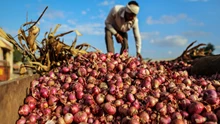
Brinjal, also known as eggplant is one of those vegetables that can become part of your everyday cuisine. Brinjals are the moderate source of vitamins and minerals like phosphorus, calcium, and iron, and nutritional value varies from variety to variety.
Brinjal is a versatile crop adapted to different agro-climatic regions. It can be grown throughout the year. In India, Brinjal covers over 8.14% of total vegetable area and produces 9% of the total vegetable production.
Here is your complete guide to grow brinjal.
Soil and Climatic Requirements
Brinjal can be grown in all soils including light sandy soil, rich loamy soil, clay loamy soil, and silt loamy soil. But most preferably, silt loamy and clay loamy soil are used for higher yield, and soil must be well-drained and fertile, and pH of soil must be ranging from 5.0 to 6.0.
And talking about climatic conditions, brinjal plant gives better yield in between the temperature ranging from 21-degree C to 28-degree C, however, it is susceptible to mild frost.
Sowing Time
Brinjal crop can be grown in both winter and summer seasons. As a winter crop, it is better to sow brinjal in between June and July month. And as a summer crop, it is better to sow brinjal in between December and January month.
Nursery and Bed Preparation for Brinjal Seedlings
Raised beds should be prepared (7-7.5)*(1.2-1.5)*(10-15). Seeds should be covered properly with FYM and Soil mixture. To avoid fungal diseases, seeds should be treated with captan and thiram @ 2kg/kg of seed. About 250-375 g of seeds is enough to cover one hectare of land with 30,000 to 45,000 seedlings. The seedlings can be transplanted in about 4-5 weeks.
Transplanting Seedlings
Seedlings are ready for transplanting within 4-5 weeks. Harden the seedlings by withholding irrigation. Without any injury to the roots, uproot the seedlings carefully. Transplanting must be done followed by irrigation, and spacing depends upon the type of soil and its fertility. In general, (75*75) cm spacing can be kept.
Nutritional Requirements
For better yield and crop quality, nutritional requirements must be fulfilled.
-
FYM- 25 tonne/ hectare
-
Nitrogen- 100kg/ hectare
-
Phosphorus- 60kg/hectare
-
Potassium- 60kg/hectare
-
NPK ratio- 5:3:3
-
Basal application- half dose of nitrogen and full dose of potassium and phosphorus.
-
Top application- leftover doze of nitrogen after 30 days
Irrigation
Once a week irrigation is sufficient during summers and irrigation in the interval of 8-10 days is sufficient for the brinjal crop.
Plant Protection
Diseases- Brinjal crop may suffer from Fuserian wilt, Phomopsis blight, little leaf, and mosaic diseases.
Pests- Mjor pests that can attack brinjal crop are fruit and shoot borer, jassids, eplilachna beetle, and mites.
As per the information from the research paper of International Journal of Current Microbiology and Applied Sciences with the heading “Effect of Different Weed Management Practices on Growth and Yield of Brinjal” by Sumeetsingh, Kulbirsingh, D.S. Khurana, and V. Sardana
"Weed has become a major problem in vegetable nurseries as well as in crops. In the rainy season weeds affect crop very badly. In this research trial, black plastic mulch is concluded as the best remedy for controlling weeds in brinjal nursery as well as crop, but it is economically high. So an integrated weed management approach should be used for the removal of weed without harming the harmony of nature."
Harvesting and Yield
Brinjals are harvest when they have attained full size and colour, but before the start of ripening. And crop yield of 30-50 tonnes/hectare can be expected.









